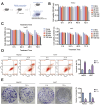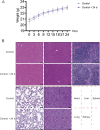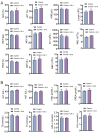A new tumor-treating device OM-100 with low-frequency magnetic fields inhibits proliferation and metastasis in liver cancer
- PMID: 39528972
- PMCID: PMC11552396
- DOI: 10.1186/s12885-024-13121-9
A new tumor-treating device OM-100 with low-frequency magnetic fields inhibits proliferation and metastasis in liver cancer
Abstract
Background: This study aims to investigate a novel instrument OM-100 with low-frequency magnetic fields (LFMFs) for its potential applicability in the treatment of liver cancer.
Methods: Liver cancer cell lines (HepG2 and Huh7) and normal liver cell line THLE-2 were exposed to OM-100 at LFMFs of 0, 10, 25, 50, and 100 kHz for 2 h in the morning, noon, and evening, respectively. The effects of LFMF on cell viability, apoptosis, migration, and invasion capabilities were examined. Additionally, impacts of LFMF on ROS production was assessed. In vivo studies were conducted to examine the safety profile of OM-100 and its effects on tumor growth.
Results: In vitro, OM-100 reduced the viability of liver cancer cells, increased cell apoptosis, and inhibited cell migration and invasion abilities in a frequency-dependent manner (P < 0.05). In vivo, OM-100 significantly slowed down tumor growth and promoted apoptosis in liver tumors (P < 0.05). Moreover, OM-100 rarely affected the viability of normal liver cells, as well as the health of normal mice. Finally, we further found that OM-100 significantly increased the production of ROS in liver cancer cells (P < 0.05), a key factor in inducing autophagy, which is very important for the progression of liver cancer.
Conclusion: Our findings reveal the safety of OM-100 and its frequency at 100 kHz significantly inhibits liver cancer progression.
Keywords: Invasion; Liver cancer; Low-frequency magnetic fields; Migration; Proliferation; Tumor treating instrument; Xenograft tumor model.
© 2024. The Author(s).
Conflict of interest statement
Figures







Similar articles
-
Anti-tumor effect of innovative tumor treatment device OM-100 through enhancing anti-PD-1 immunotherapy in glioblastoma growth.Sci Rep. 2024 Aug 8;14(1):18444. doi: 10.1038/s41598-024-67437-4. Sci Rep. 2024. PMID: 39117725 Free PMC article.
-
Pentoxifylline induces apoptosis of HepG2 cells by reducing reactive oxygen species production and activating the MAPK signaling.Life Sci. 2017 Aug 15;183:60-68. doi: 10.1016/j.lfs.2017.05.029. Epub 2017 Jun 2. Life Sci. 2017. PMID: 28583366
-
Inhibition of cancer cell growth by oleanolic acid in multidrug resistant liver carcinoma is mediated via suppression of cancer cell migration and invasion, mitochondrial apoptosis, G2/M cell cycle arrest and deactivation of JNK/p38 signalling pathway.J BUON. 2019 Sep-Oct;24(5):1964-1969. J BUON. 2019. PMID: 31786862
-
A novel peptide, 9R-P201, strongly inhibits the viability, proliferation and migration of liver cancer HepG2 cells and induces apoptosis by down-regulation of FoxM1 expression.Eur J Pharmacol. 2017 Feb 5;796:175-189. doi: 10.1016/j.ejphar.2016.12.029. Epub 2016 Dec 21. Eur J Pharmacol. 2017. PMID: 28012972
-
Protective effects of low-frequency magnetic fields on cardiomyocytes from ischemia reperfusion injury via ROS and NO/ONOO-.Oxid Med Cell Longev. 2013;2013:529173. doi: 10.1155/2013/529173. Epub 2013 Nov 7. Oxid Med Cell Longev. 2013. PMID: 24312697 Free PMC article.
Cited by
-
Effects of non-contact electric fields on the kidneys and livers of tumour-bearing rats.F1000Res. 2025 Feb 11;12:117. doi: 10.12688/f1000research.110080.6. eCollection 2023. F1000Res. 2025. PMID: 39931163 Free PMC article.
References
-
- Wang J, Yu H, Dong W, et al. N6-Methyladenosine-mediated Up-Regulation of FZD10 regulates Liver Cancer Stem cells’ properties and Lenvatinib Resistance through WNT/β-Catenin and Hippo Signaling Pathways. Gastroenterology. 2023;164(6):990–1005. - PubMed
MeSH terms
Substances
LinkOut - more resources
Full Text Sources
Medical

